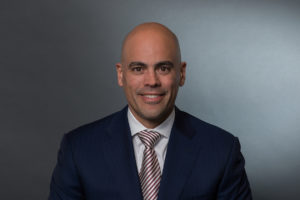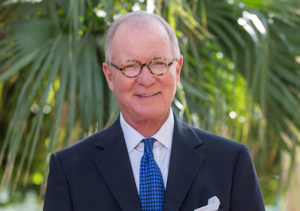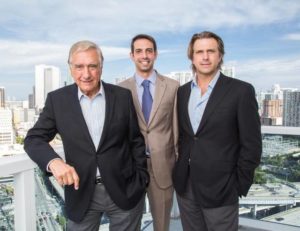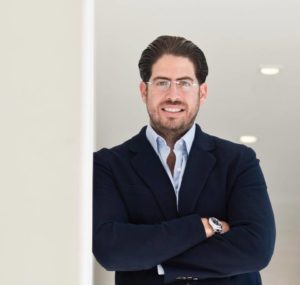How transportation companies prepare for the future using the infrastructure of the past
Vincent Signorello, President & CEO – Florida East Coast Industries
What advantages does Florida East Coast Industries (FECI) hold when it comes to Florida’s infrastructure development?
Established more than a century ago by American pioneer Henry Flagler, Florida East Coast Industries is the parent company of many leading real estate, transportation and infrastructure businesses. Our primary assets—namely Henry Flagler’s railroad infrastructure and prime land holdings—laid the foundation for our companies. We are continuing to leverage these unparalleled assets to either promote the businesses that have historically been built around them, or to build new businesses that help contribute to our overall goals.
The Florida East Coast Railway has long been an economic catalyst for the state, strategically moving both people and goods. When it comes to Miami’s logistics sector, what are the growth drivers?
Miami’s advantage in logistics is linked to the fact that its industrial complex is highly connected to Latin America. In fact, a significant amount of the warehousing in South Florida is occupied with many products that are ultimately destined for the region, whether that comes in through PortMiami or other South Florida ports. Miami’s unique position as a logistics hub helps companies like ours expand our industrial footprint. To do this, we are making smart investments in both Latin America and the Caribbean, and also leveraging the hub—that is, we are using Miami-based human resources, technology and ownership of assets to benefit the projects that we develop elsewhere.
FECI is also investing greatly in Florida infrastructure, specifically transit-oriented development. What trends do you see in that space?
The next generation of Floridians want to live, work and recreate near transit. We are actively addressing that demand by developing a network, some of which, like Brightline, is transportation infrastructure, and some of which is real estate infrastructure. From these projects, there are number of lessons. For one, we are financing and executing Brightline without any public funds. Because private entities are concerned with the time value of money and because private projects are less subject to bureaucratic processes that bog them down, such projects can be completed in a more timely and cost-effective manner. For another, our transit-oriented developments capitalize on existing assets, namely rail infrastructure, to build a pedestrian-friendly environment and connect residents and commuters with transit options.
How Miami-Dade’s public and private sectors are addressing the strain of rapid growth on the county’s underlying infrastructure
Jose R. Mas CEO – MasTec
How is Miami’s development boom affecting the county’s infrastructure?
 We are growing up as a city and to sustain this, we need to think about infrastructure. One issue that is not a priority, but should be, is our water and sewer systems. Our physical plant hasn’t been updated in decades and it is decaying fast. This is a hard political issue because we would have to spend money on it. We are also seeing limitations in terms of electricity. We don’t have the land to create big power-generation plants to support the pace of development. One option is to expand the existing power plants across the state, but this would mean putting in power lines, which is difficult because of environmental issues. Florida Power and Light (FPL) is trying to build a new transmission line from Turkey Point all the way to Downtown Miami and they are facing some community opposition. No one wants to see those big power lines on their street, but we have to find the right balance between aesthetics and meeting our growing needs. If something doesn’t happen soon, construction will have to slow down because electric utilities will not be able to meet the demands of those buildings. In terms of a viable renewable resource, there has been discussion about putting wind turbines in the Gulf Stream to generate hydroelectricity. Solar is another promising frontier for us.
We are growing up as a city and to sustain this, we need to think about infrastructure. One issue that is not a priority, but should be, is our water and sewer systems. Our physical plant hasn’t been updated in decades and it is decaying fast. This is a hard political issue because we would have to spend money on it. We are also seeing limitations in terms of electricity. We don’t have the land to create big power-generation plants to support the pace of development. One option is to expand the existing power plants across the state, but this would mean putting in power lines, which is difficult because of environmental issues. Florida Power and Light (FPL) is trying to build a new transmission line from Turkey Point all the way to Downtown Miami and they are facing some community opposition. No one wants to see those big power lines on their street, but we have to find the right balance between aesthetics and meeting our growing needs. If something doesn’t happen soon, construction will have to slow down because electric utilities will not be able to meet the demands of those buildings. In terms of a viable renewable resource, there has been discussion about putting wind turbines in the Gulf Stream to generate hydroelectricity. Solar is another promising frontier for us.
How will the use of public-private partnerships (PPPs) address South Florida’s infrastructure needs?
PPPs are more efficient than wholly public sector-managed projects because private companies are more efficient when it comes to deploying capital. The major challenge comes about when public amenities turn into business ventures. Right now, we pay very low rates for water. But if Miami-Dade Water and Sewer Department (WASD) becomes a public-private venture, rates may go up. WASD is a significant monetary contributor for the county. What will happen if we take that source of income away from the county’s general budget? While there is a tradeo, we need to invest in our infrastructure for our long-term needs.
MasTec is also active in building telecommunications infrastructure. How will this evolve in Miami-Dade?
Technology is a big driver for our future, and we are going to see a massive expansion of gigabyte speed internet. Although we have a great telecommunications infrastructure, most of the facilities in Miami are still copper-based and it would take rebuilding the infrastructure to increase of the amount of fiber that is needed to give consumers higher speeds and much higher bandwidths.
Invest: Miami speaks to Joseph Kavana, CEO
When we purchased the land for Metropica over 20 years ago, we recognized development could move in two directions: north from Miami-Dade or west from Eastern Broward. Sunrise was an ideal location as it is at South Florida’s epicenter, close to four counties and four highways, including I-95 and the Turnpike. Despite proximity to these highways, we don’t have the traffic issues other areas have.
Sunrise’s enormous potential is no secret. Companies are migrating to the area, portending job growth. In 2014, American Express relocated its regional headquarters to Sunrise. The building is currently under construction and will bring over 6,000 jobs to the area. Organizations contributing to job growth and critical mass in West Broward include Cleveland Clinic, Nova Southeastern University, Florida Atlantic University, Broward College, HBO Latin America, the FBI Miami Field Office and the BB&T Center—all close to Metropica.
Setting Metropica apart from similar mixed-use projects is its design and the size of its land. The 65 acres have office, residential and retail areas, with the residential area in the center. Spanning 20 acres, a park and recreational areas surround eight luxury condominium towers. Residents will easily access amenities and enjoy unique dining, shopping and entertainment. Although these elements are close by, the project balances peaceful living and a lively downtown area to cater to buyers’ needs. Though Broward sees much business activity, people move here to find peace and harmony and avoid chaotic city life.
We are creating an oasis in a suburban setting. Moreover, as a transit-oriented development, Metropica promotes pedestrian life and bike use. Because we are located at the edge of the Everglades, it is important to minimize our environmental impact. Ultimately, not only are we creating a place to enjoy your days, but a place you will love to live in.
Invest: Miami speaks with Brad Meltzer, Southeast President
Compared to major global cities, Miami is an infant. When folks look back on this market, they will say that this is the moment when Miami matured from a vacation destination to a city with strong cultural offerings and business opportunities. Many people in our industry are coming to Miami because of the growth opportunities, not just because their families are rooted here. The more highly trained and educated entrepreneurs that come here, the better “fertilized” this market will be.
A trend in the residential segment is a movement toward larger units. Luxury buyers want more space while out-of-town buyers are bringing their families here, not simply using units as investment property or vacation homes/rentals. Another key development is the 50-percent deposit requirement for pre-construction sales. This has strengthened the buyer pool and validates the market.
Though there is a labor constraint, it is not localized at the general labor level. The volume of development has dramatically increased and the industry is stressed, from general contractors to architects, engineers and developers. In addition, city inspectors are stressed, affecting our ability to get timely inspections needed to maintain schedules. To keep pace, we recruit qualified staff from outside South Florida, while firms in the market are routinely poaching labor from one another.
For a long time, South Florida was stigmatized as an unsophisticated market for construction and design. As an increased level of savvy buyers entered the market, and projects started to command higher prices, the quality of developments and design improved. Today, world-class architects are designing sophisticated and innovative projects here. Additionally, South Florida is emerging as a leader in green buildings. LEED requirements spur builders to integrate eco-efficient, low-voltage systems, temperature and climate control and glazing materials, to name a few.
Invest: Miami speaks to Jeffrey Gouveia, President and General Manager, Southeast Region
Miami is a progressive market when it comes to construction and development. The proof can be seen in the amazing projects  that have gotten approvals and are under construction. Buildings in Miami are getting more complex. They are not just functional, but they are making bold statements. This is a testament to the creative environment that Miami fosters. This creativity allows for a broad diversity of products to be developed. You don’t see much conformity here like you might in other cities.
that have gotten approvals and are under construction. Buildings in Miami are getting more complex. They are not just functional, but they are making bold statements. This is a testament to the creative environment that Miami fosters. This creativity allows for a broad diversity of products to be developed. You don’t see much conformity here like you might in other cities.
One challenge to this market’s growth potential is labor costs. We have seen these surge tremendously, and it is a concern for the industry at large. Fortunately, we at Suffolk have a consistent group of trade partners that we work with on many of the larger projects that draw the most labor, allowing us to come up with the most efficient design and make decisions that are calculated, rather than reactive. Intensive planning is key. Part of our strategy is to get people involved as early as possible so that we can make the best plans and begin assembling our teams and allocating labor before construction begins.
The South Florida market continues to show strong potential. High-end luxury residential product remains viable, mostly because there is a limited number of the super high-end units, and these projects are intended for a select group of buyers. So long as the balance remains consistent, that market will continue to see strong performance. Another high-performing area is retail. The fact that there are two giant mixed-use projects— Brickell City Centre and Miami Worldcenter—with massive retail components being built so close to each other speaks to the level of demand for more shopping options in this city. When people think of Miami they think of style; they think of high-end brands. All of these things speak to the fact that Miami is an international city—a true global destination. There is a certain energy here. And because of these factors, people continue to come in droves.
How mixed-use developments are bringing world-class buyers to Miami and making it a global real estate destination
Stephen Owens President – Swire Properties
Does the fact that Brickell City Centre is a mixed-use development insulate it from the slowdown affecting other projects in the Miami market?
in the Miami market?
Today, retailers across the globe are a little more cautious about expanding because of economic conditions in Europe, Asia and Latin America—all of which have struggled in 2015. While Miami’s condo market remains active, and while Swire continues to sell units at a good pace compared to other developers, this activity is half of what we were seeing in 2013 and 2014. All of these factors have been exacerbated by the strong U.S. dollar, which contributed to the late 2015 cooling of Miami’s condominium market. On the other hand, Miami’s hotel market—the third best in the country—continues to be promising. The benefit of the multi-use concept is that—whether we find ourselves in a booming economy, or one that, like today’s, is a little bit more stable—the synergistic sum of the parts is collectively greater than the individual parts.
What does the future for mega projects in Miami look like?
As the conditions of the market become more diffcult, one’s ability to deliver another project with the same elements as Brickell City Centre becomes much more challenged. We can attest to the complexity of executing a project like this—and in our case, there was only one developer who controlled all aspects of the project. We did not have to coordinate between multiple developers, contractors, architects, owners and lawyers, and it was still a challenge. Developers will have to face these challenges in building mega projects while helping Miami’s transportation issues and contributing to the city’s economy.
In October 2015, Swire submitted building plans for the remaining undeveloped land on Brickell Key. What are the company’s plans for this land?
Some would argue that the undeveloped waterfront land on Brickell Key is the most valuable and prestigious real estate left in Miami’s urban area. We think the site is appropriate for luxury residencies. Moreover, the area’s proximity to Brickell City Centre, with all the new retail and dining options it will offer, will make this land even more valuable than it already is. The more value we create for Brickell City Centre, the more value is added to Brickell Key. It’s like having a fine wine in your cellar that you can only drink once in your lifetime. From our perspective, this land will only become more valuable the longer we wait as there are only a few sites left and we are thinking about what to do with the best one—there is an enhancement value in simply holding. We are going to take our time in the future developing this final site.
Invest: Miami speaks to Michael Wohl, Partner
In Miami-Dade, housing costs, relative to wages, is quite high. Demand for affordable housing continues to rise, but so do the costs of land and construction. Traditionally, affordable housing funds are comprised of federal, state and municipal subsidies. In Miami-Dade County, we have a surtax—an excess tax levied on the sale of land and commercial property— which annually generates between $50 million and $70 million, which can be used to facilitate affordable housing. Another financing vehicle is funds issued through the Local Housing Finance Agency.
Some of our projects are “mixed-income,” comprised of a ordable and market-rate housing. Funding from the affordable components covers the costs of building the parking garage, the infrastructure and much of the construction. Using the savings from that reduced expense, we are able to offer a rent that is below market rate. For instance, our rents at Brickell View Terrace, a project in West Brickell, will be 25 percent less than the market-rate. That project has 100 units of affordable housing and 76 units of market-rate housing. Our Gibson project in Coconut Grove has 56 units, six of which are market-rate. It will provide predominantly senior housing, and also have a school that offers daytime adult education.
We also invest heavily in the public spaces of our projects, installing prominent works of art and incorporating attractive design features. We want to change the public perception of affordable housing, as well as create an attractive community for our residents. Broadly speaking, I think there should be obligations for major developments to provide affordable housing, and these should be enforced. Frankly, I don’t think that major development should go on unless there is an indication that the workforce and the affordable housing needs of that community have been taken care of.
Invest: Miami speaks with Jose Luis F. Melo, Carlos F. Melo, and Martin F. Melo, Directors of Melo Group
 When Melo first began developing in the Edgewater neighborhood in 2001, there was nothing here, but we always understood that this was premium space. While many people believe it is easy to purchase property with water views in the City of Miami, today there are fewer and fewer lots that offer this. Edgewater is the last waterfront frontier in the City of Miami, and, as such, we began acquiring land with long-term plans to develop it.
When Melo first began developing in the Edgewater neighborhood in 2001, there was nothing here, but we always understood that this was premium space. While many people believe it is easy to purchase property with water views in the City of Miami, today there are fewer and fewer lots that offer this. Edgewater is the last waterfront frontier in the City of Miami, and, as such, we began acquiring land with long-term plans to develop it.
Our current project, Aria on the Bay, is the last and largest parcel and we refer to it as the “queen of the block.” Apart from the cutting-edge design and world-class amenities, this building benefits from its Edgewater location, which offers excellent views, quick and easy access to Miami Beach, surrounding parks and proximity to important cultural institutions: the Perez Art Museum Miami, the Adrienne Arsht Center for the Performing Arts and, very soon, the Frost Museum of Science, which is currently under construction.
Edgewater is no longer the blighted area it was when we rst started, and word has gotten out. We have seen strong interest in our condominium projects from international buyers. These buyers are coming from very diverse places–from Austria, Morocco and Italy—in addition to the traditional markets from Miami: Argentina, Brazil, Colombia and Venezuela. With recently announced direct flights from Miami to Qatar and Turkey, we will see more newcomers to this market.
Because Miami’s real estate market relies heavily on international buyers, there is concern when you have a strong U.S. dollar like we have been seeing this year. While there has been some impact on condominium sales as a result of the exchange rate, the allure that Miami has for foreign buyers will outweigh the effects of currency devaluation. At the end of the day, the opportunity to live in the U.S.—with all of the associated political freedoms, the physical security, the stability of its economic system, the soundness of its judicial system and processes—is priceless.
How temporary slowdowns do not undermine the strength of Miami’s real estate
David Martin President – Terra
How are developers coping with the slowdown in the luxury condominium market?
There is an assumption that demand has cooled, but you have to realize that Miami is comprised of different neighborhoods, some of which have higher barriers to entry than others. There is scarcity of oceanfront product, developable areas in Coconut Grove and land in Doral for single-family homes. With scarcity comes an opportunity to develop special projects, as Terra is doing in Coconut Grove, Weston and North Beach, areas that are still seeing thriving demand and price appreciation. In the end, the value proposition offered by certain real estate asset classes in particular submarkets will dictate what pricing will bear. That’s why Terra invests in neighborhoods with high barriers to entry and “voids” in the market. Real estate demand in Miami, whether for residential, office space, shopping centers or industrial, is vibrant and strong—especially over the long term.
For exurban development, what are the key trends?
Whether you are talking about urban or suburban development, people are looking for better quality of life. In the urban core, that exists in walkability, access to parks, shops, restaurants and culture. Buyers accustomed to life in a single-family home are drawn to the idea of living in a high-rise that is home to like-minded residents and new quality-of-life offerings. In suburban areas, you have peace, natural environments, top-rated schools, a village-like community. Critical mass is building in suburbs like Doral, Dadeland and Weston; we’re finding nodes with urban characteristics emerging. We’re seeing mini urban cores with office, hotel and residential being developed around anchors. In the case of Dadeland, it’s Dadeland Mall. In Weston, it’s Cleveland Clinic.
How might you characterize the evolution of the residential luxury product in this market?
Miami is about people discovering it, falling in love with it and then moving here or buying a place. Much of the world is looking to Miami as a stable place to invest. We’re seeing flight capital enter the market from Europe, Latin America and Asia, with the ultra-premium buyer segment being particularly active. What’s interesting is where and how they spend their money once here. Our developments are attracting worldly, sophisticated buyers coming from Latin America, New York and the U.S. If you can pique their intellectual interest with your product, then you are contributing something to the market. We’re seeing a shift toward “intelligent luxury,” which I define as buyers looking to “be” more, rather than “have” more.


 We are growing up as a city and to sustain this, we need to think about infrastructure. One issue that is not a priority, but should be, is our water and sewer systems. Our physical plant hasn’t been updated in decades and it is decaying fast. This is a hard political issue because we would have to spend money on it. We are also seeing limitations in terms of electricity. We don’t have the land to create big power-generation plants to support the pace of development. One option is to expand the existing power plants across the state, but this would mean putting in power lines, which is difficult because of environmental issues. Florida Power and Light (FPL) is trying to build a new transmission line from Turkey Point all the way to Downtown Miami and they are facing some community opposition. No one wants to see those big power lines on their street, but we have to find the right balance between aesthetics and meeting our growing needs. If something doesn’t happen soon, construction will have to slow down because electric utilities will not be able to meet the demands of those buildings. In terms of a viable renewable resource, there has been discussion about putting wind turbines in the Gulf Stream to generate hydroelectricity. Solar is another promising frontier for us.
We are growing up as a city and to sustain this, we need to think about infrastructure. One issue that is not a priority, but should be, is our water and sewer systems. Our physical plant hasn’t been updated in decades and it is decaying fast. This is a hard political issue because we would have to spend money on it. We are also seeing limitations in terms of electricity. We don’t have the land to create big power-generation plants to support the pace of development. One option is to expand the existing power plants across the state, but this would mean putting in power lines, which is difficult because of environmental issues. Florida Power and Light (FPL) is trying to build a new transmission line from Turkey Point all the way to Downtown Miami and they are facing some community opposition. No one wants to see those big power lines on their street, but we have to find the right balance between aesthetics and meeting our growing needs. If something doesn’t happen soon, construction will have to slow down because electric utilities will not be able to meet the demands of those buildings. In terms of a viable renewable resource, there has been discussion about putting wind turbines in the Gulf Stream to generate hydroelectricity. Solar is another promising frontier for us. that have gotten approvals and are under construction. Buildings in Miami are getting more complex. They are not just functional, but they are making bold statements. This is a testament to the creative environment that Miami fosters. This creativity allows for a broad diversity of products to be developed. You don’t see much conformity here like you might in other cities.
that have gotten approvals and are under construction. Buildings in Miami are getting more complex. They are not just functional, but they are making bold statements. This is a testament to the creative environment that Miami fosters. This creativity allows for a broad diversity of products to be developed. You don’t see much conformity here like you might in other cities. in the Miami market?
in the Miami market? When Melo first began developing in the Edgewater neighborhood in 2001, there was nothing here, but we always understood that this was premium space. While many people believe it is easy to purchase property with water views in the City of Miami, today there are fewer and fewer lots that offer this. Edgewater is the last waterfront frontier in the City of Miami, and, as such, we began acquiring land with long-term plans to develop it.
When Melo first began developing in the Edgewater neighborhood in 2001, there was nothing here, but we always understood that this was premium space. While many people believe it is easy to purchase property with water views in the City of Miami, today there are fewer and fewer lots that offer this. Edgewater is the last waterfront frontier in the City of Miami, and, as such, we began acquiring land with long-term plans to develop it.